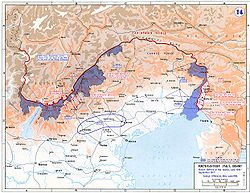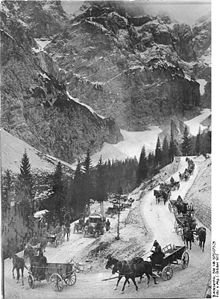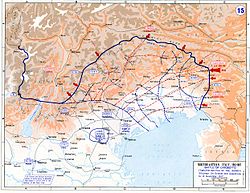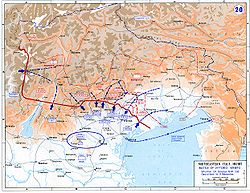Italian Campaign - Picture
More about World War 1

|
|
Italian Campaign
Italian Front
Date: 23 May 1915 - 3/4 November 1918
Location: Eastern Alps
Result
Italian victory, Collapse of the Austro-Hungarian Empire, Treaty of Trianon
Date: 23 May 1915 - 3/4 November 1918
Location: Eastern Alps
Result: Italian victory, Collapse of the Austro-Hungarian Empire, Treaty of Trianon
Belligerents:
: Italy
United Kingdom
France
United States
Commanders and leaders:
: Armando Diaz
Luigi Cadorna
Strength:
: 5,000,000
Casualties and losses:
: 651,000 Military deaths
953,886 wounded
The Italian campaign refers to a series of battles fought between the armies of Austria-Hungary and Italy, along with their allies, in northern Italy between 1915 and 1918. Italy hoped that by joining the countries of the Triple Entente against the Central Powers it would gain Cisalpine Tyrol (today's provinces of Trentino and South Tyrol), the Austrian Littoral, and northern Dalmatia. Although Italy had hoped to begin the war with a surprise offensive intended to move quickly and capture several Austrian cities, the war soon bogged down into trench warfare similar to the Western Front fought in France.
Causes for the campaign
Although a member of the Triple Alliance with Austria-Hungary and Germany, Italy did not declare war in August 1914, arguing that the Alliance was defensive in nature and therefore that Austria-Hungary's aggression did not obligate Italy to take part. Italy had a longstanding rivalry with Austria-Hungary, dating back to the Congress of Vienna in 1815 after the Napoleonic Wars, which granted several regions on the Italian peninsula to the Austrian Empire. More importantly, a radical nationalist political movement, called Unredeemed Italy (Italia irredenta), founded in the 1880s, started claiming the Italian-inhabited territories of Austria Hungary, especially in the Austrian Littoral and in the County of Tyrol. By the 1910s, the expansionist ideas of this movement were taken up by a significant part of the Italian political elite. The liberation and annexation of those Austrian territories (inhabited not only by Italians, but also by ethnic Germans, South Slavs and Friulians) became the main Italian war goal, assuming a similar function as the issue of Alsace-Lorraine had for the French.
In the early stages of the war, Allied diplomats courted Italy, attempting to secure Italian participation on the Allied side, culminating in the Treaty of London of April 26, 1915 in which Italy renounced her obligations to the Triple Alliance. On May 23, Italy declared war on Austria-Hungary.
Campaigns of 1915-1916

Picture - Italian Front in 1915-1917: eleven Battles of the Isonzo and Asiago offensive. In blue, initial Italian conquests.
First battles of Isonzo river
Italy opened the war with an offensive aimed at capturing the town of Gorizia on the Isonzo (Slovene: SoÄŤa) river, and capturing the highlands on the Kras plateau and in the western Julian March, which would enable them to secure a further advance towards Trieste, Rijeka (Fiume), Kranj (Krainburg) and Ljubljana (Laibach). However, the Italian Army was poorly equipped in artillery, vehicles, and ammunition. At the beginning of the war, Italy had just 600 vehicles to move troops. As with most contemporary militaries, the Italian army primarily used horses for transport, and these failed to move supplies fast enough in the tough terrain of the Alps. Also, the newly appointed Italian commander, Luigi Cadorna, had no combat experience and was highly unpopular amongst his men.
At the beginning of the offensive, Italian forces outnumbered the Austrians 2 to 1, but failed to penetrate their strong defensive lines along the Julian Alps and the northwestern highlands of the Goriška region. This was mostly due to the Austrian forces being based on higher ground, and so Italian offensives had to be conducted climbing. Two weeks later, the Italians attempted another frontal assault with more artillery but were beaten back again. Another attack was mounted from October 18 to November 4 with 1,200 heavy guns, which again resulted in no gain.
The Asiago offensive
Following Italy's disastrous offensives, the Austrians began planning a counteroffensive (Strafexpedition) in Trentino and directed over the plateau of Altopiano di Asiago, with the aim to break through to the Po River plain and thus cutting off the II., III., and IV. Italian Armies in the North East of the country. The offensive began on March 11, 1916 with 15 divisions breaking the Italian lines. Though warned of an impending offensive, the local Italian commander had chosen to conduct local offensives instead of preparing a defense. The unprepared Italian positions collapsed and Italy only staved off defeat by quickly transferring reinforcements from other fronts.
Later battles for the Isonzo

Picture - Austro-Hungarian supply line over the VršiÄŤ pass. October 1917
Later in 1916, four more battles along the Isonzo river erupted. The Sixth Battle of the Isonzo, launched by the Italians in August, resulted in a success greater than the previous attacks largely because the Austrians had depleted their lines for the Brusilov Offensive. The offensive gained nothing of strategic value but did take Gorizia, which boosted Italian spirits. The Seventh, Eighth, and Ninth battles of the Isonzo (September 14-November 4) managed to accomplish little except to wear down the already exhausted armies of both nations.
The frequency of offensives for which the Italian soldiers partook between May 1915 and August 1917, one every three months, was higher than demanded by the armies on the Western Front. Italian discipline was also harsher, with punishments for infractions of duty of a severity not known in the German, French, and British armies.
Shellfire in the rocky terrain caused 70% more casualties per rounds expended than on the soft ground in Belgium and France. By the autumn of 1917 the Italian army had suffered most of the deaths it was to incur during the war, yet the end of the war seemed to still be an eternity away. This was not the same line of thought for the Austrians. On August 25, the Emperor Charles wrote to the Kaiser the following: "The experience we have acquired in the eleventh battle has led me to believe that we should fare far worse in the twelfth. My commanders and brave troops have decided that such an unfortunate situation might be anticipated by an offensive. We have not the necessary means as regards troops."
On 13 December 1916, known as 'White Friday', 10,000 soldiers were killed by avalanches in the Dolomites.
1917: Germany arrives

Picture - Battle of Caporetto and Italian retreat to the Piave river.
Following the minuscule gains of the Tenth Battle of the Isonzo, the Italians directed a two-pronged attack against the Austrian lines north and east of Gorizia. The Austrians easily checked the advance east, but Italian forces under Luigi Capello managed to break the Austrian lines and capture the Bainsizza (Banjšice) Plateau. Characteristic of nearly every other theater of the war, the Italians found themselves on the verge of victory but could not secure it because their supply lines could not keep up with the front-line troops and they were forced to withdraw.
The Austrians received desperately needed reinforcements after the Eleventh Battle of the Isonzo from German Army soldiers rushed in after the Russian offensive ordered by Kerensky (Kerensky Offensive) of July 1917 failed. The Germans introduced infiltration tactics (Hutier tactics) to the Austrian front and helped work on a new offensive. Meanwhile, mutinies and plummeting morale crippled the Italian Army from within. The soldiers lived in poor conditions and engaged in attack after attack that often yielded minimal or no military gain. On October 24, 1917 the Austrians and Germans launched the Battle of Caporetto (Italian name for Kobarid) with a huge artillery barrage followed by infantry using Hutier tactics, bypassing enemy strong points and attacking on the Italian rear. At the end of the first day, the Italians had retreated 12 miles to the Tagliamento River.
1918: The war ends
Battle of the Piave
Advancing deep and fast, the Austrians overran their supply lines, which forced them to stop and regroup. The Italians, pushed back to defensive lines near Venice on the Piave River, had suffered 600,000 casualties to this point in the war. Because of these losses, the Italian Government called to arms the so-called '99 Boys (Ragazzi del '99), that is, all males who were 18 years old. In November 1917, British, French and US forces started to bolster the front line, though not in decisive numbers; the Italians were able to contain the Austrian offensive largely by themselves. Far more decisive than Allied help in troops, indeed, was Franco-British (and US) help provided in those strategic materials (coal, steel, etc.) Italy always lacked sorely. In the spring of 1918, Germany pulled out its troops for use in its upcoming Spring Offensive. The Austrians now began debating how to finish the war in Italy. The Austro-Hungarian generals disagreed on how to administer the final offensive. Archduke Joseph August of Austria decided for a two-pronged offensive, where it would prove impossible for the two forces to communicate in the mountains.
The Battle of the Piave River began with a diversionary attack near the Tonale Pass named Lawine, which the Italians easily repulsed after two days of fight. Austrian deserters betrayed the objectives of the upcoming offensive, which allowed the Italians to move two armies directly in the path of the Austrian prongs. The other prong, led by general Svetozar Boroević von Bojna initially experienced success until aircraft bombed their supply lines and Italian reinforcements arrived.

Picture - Italian front in 1918 and battle of Vittorio Veneto.
The decisive Battle of Vittorio Veneto
To the disappointment of Italy's allies, no counter-offensive followed the Battle of Piave. The Italian Army had suffered huge losses in the battle, and considered an offensive dangerous. General Armando Diaz waited for more reinforcements to arrive from the Western Front. By October 1918, Italy finally had enough soldiers to mount an offensive. The attack targeted Vittorio Veneto, across the Piave. Though Austrian soldiers fought fiercely, the superior numbers of the Italians overwhelmed them. The Italians broke through a gap near Sacile and poured in reinforcements that crushed the Austrian defensive line. On the 3rd of November; 300,000 Austrian soldiers surrendered. The Battle of Vittorio Veneto heralded the dissolution of the Austro-Hungarian Army as an effective fighting force, and also triggered the disintegration of Austria-Hungary. During the last week of October, declarations made in Budapest, Prague, and Zagreb proclaimed the independence of their respective parts of the old empire. On October 29 the imperial authorities asked Italy for an armistice, but the Italians continued to advance, reaching Trento, Udine, and Trieste. On November 3, Austria-Hungary sent a flag of truce to the Italian Commander to ask again for an Armistice and terms of peace. The terms were arranged by telegraph with the Allied Authorities in Paris, communicated to the Austrian Commander, and were accepted. The Armistice with Austria was signed in the Villa Giusti, near Padua, on November 3, and took effect on November 4, at three o'clock in the afternoon. Austria and Hungary signed separate armistices following the overthrow of the Habsburg Monarchy and the collapse of the Austro-Hungarian Empire.
Austria-Hungary
Bollettino della Vittoria
History of Austria
History of Hungary
History of South Tyrol
Italy in World War I
Mortara, G (1925). La Salute pubblica in Italia durante e dopo la Guerra. New Haven: Yale University Press.
Erlikman, Vadim (2004). Poteri narodonaseleniia v XX veke : spravochnik. Moscow. ISBN 5931651071.
Cassar, George H. (1998). The Forgotten Front: The British Campaign in Italy, 1917-1918. London: Continuum International Publishing Group. ISBN 185285166X.
Nicolle‏, David (2003). The Italian Army of World War I. Osprey Publishing‏. ISBN 1841763985.
Page, Thomas Nelson, (1920) "Italy and the World War". New York, Charles Scribner's Sons, Full Text Available Online.
Keegan, John (2001). The first World War; An Illustrated History. London: Hutchinson. ISBN 0091793920.
Thompson, Mark (2008). The White War: Life and Death on the Italian Front, 1915-1919. London: Faber and Faber. ISBN 0465013295.
More aircraft.
Source: WikiPedia